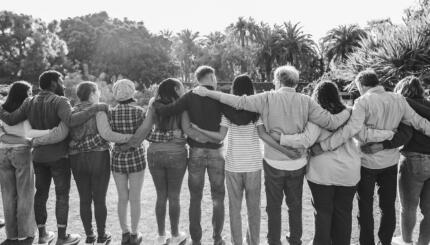Does God need our prayers?
In a word, yes. God does need our prayers, but not in the way people sometimes think.
It’s not that there is a vain, insecure God up in heaven who loves to hear praise and exaltation. Rather, we are the necessary other half of a mutually beneficial relationship. God needs a home in the world and prayer is where we build that home.
We can start to understand why God needs our prayers with a saying of Rabbi Menachem Mendel of Kotzk, the 19th-century Hasidic master known as the Kotzker Rebbe: “Where is God? God is where you let Him in.” That is, God may be a reality in heaven, but if we want God to be manifest in the world, we need to bring God into our hearts and minds and actions.
With your help, My Jewish Learning can provide endless opportunities for learning, connection and discovery.
Rabbi Nehemia Polen once put it this way: God has a disability. God is invisible and doesn’t have a physical body. We need to be God’s arms, legs, eyes, ears and hands in the world.
Plenty of people go about their days without much (or any) feeling that God is in their lives. We go to work, talk to colleagues, eat lunch, get stuck in traffic. The Kotzker’s saying reminds us that we have a choice: We can see God in our lives or not.
We can watch a sunset and think it’s only light rays reflecting off the atmosphere, or we can feel awe at the beauty of creation. We can see an act of kindness and cynically look for the ulterior motive behind it, or see it as a reflection of the everlasting love that binds the cosmos together.
There’s a joke about this: A man was driving in New York city and needed to find a parking spot quickly or he’d be late for an important meeting. He started to pray to God, “Please, God, find me a parking spot! I promise, I’ll go to synagogue every week! I’ll give 20 percent of my money to charity!” Suddenly, right in front of him, a car pulls out leaving a perfect parking space. He says, “Oh, never mind, I found one.”
Even if we are waiting for a miracle or a sign, we may not be ready to see it. Waiting for God to convince us is not a very reliable strategy if we want to see God in our lives.
Prayer can be a way of training our eyes to see. “Prayer takes the mind out of the narrowness of self-interest,” Abraham Joshua Heschel wrote, “and enables us to see the world in the mirror of the holy.”
Kalonymus Kalman Shapira, also known as the Piazetzner Rebbe, was a 20th-century Polish rabbi who led his followers in the Warsaw Ghetto until he was murdered in a Nazi labor camp in 1943. Shapiro pointed out that human visual perception isn’t a mechanical process of light hitting the eyes. Rather, it is a process that takes place in the brain as we synthesize the physical information into pictures and forms that make sense to us.
Shapiro concludes that seeing is flexible. We can learn to see the world differently. We can retrain our eyes to see the world in the mirror of the holy.
Prayer is that retraining ground. It is an opportunity to focus on our relationship to the holy and, in the process, bring God into the world.
Prayer can help remind us of the daily miracles right in front of our eyes. In our morning prayers we recite: Baruch ata adonai yotzer ha-me’orot. Blessed are you God, who creates the lights. Looking out the window at the morning sky, this blessing is a reminder that the dawning of a new day is also a the dawning of new hope and the ever present possibilities that darkness can be transformed into light.
The ancient Hebrew words of the Jewish prayer book are rich and evocative and can open up the imagination. The regular practice of Jewish prayer connects us to the God-spark in our souls, a connectedness that then carries through the day.
Jewish prayer isn’t the only way to do this, of course. Making art, for example, can also be a form of prayer, forcing us to slow down and pay attention to the beautiful shapes and colors of the world, training our eyes to see God in the world. But however we train ourselves to see God in every living being and the holy in every interaction, we also change not just ourselves but the world around us.
To quote Heschel again: “Great is the power of prayer. For to worship is to expand the presence of God in the world. God is transcendent, but our worship makes Him immanent.”
God needs our prayers because God needs us to be active partners in making holiness manifest in this world — not just in heaven. When we come out of our prayers seeing holiness in every face, seeing everyone as an image of God, and we work to make sure this becomes a reality, God’s presence has truly been expanded.
Rabbi Natan Margalit is the founder and president of Organic Torah, a non-profit organization that fosters holistic thinking about Judaism and the environment. He received rabbinic ordination from the Jerusalem Seminary earned a doctorate in Talmud from the University of California, Berkeley.



